Design Thinking: Concepts and Applications
VerifiedAdded on 2020/03/28
|13
|3241
|279
AI Summary
This assignment delves into the multifaceted concept of design thinking. It requires students to examine the origins, core principles, and diverse applications of design thinking across various fields. The analysis should encompass the evolution of design thinking, its influence on innovation, and its potential for addressing complex challenges. Students are encouraged to explore real-world examples and critically evaluate the strengths and limitations of this approach.
Contribute Materials
Your contribution can guide someone’s learning journey. Share your
documents today.
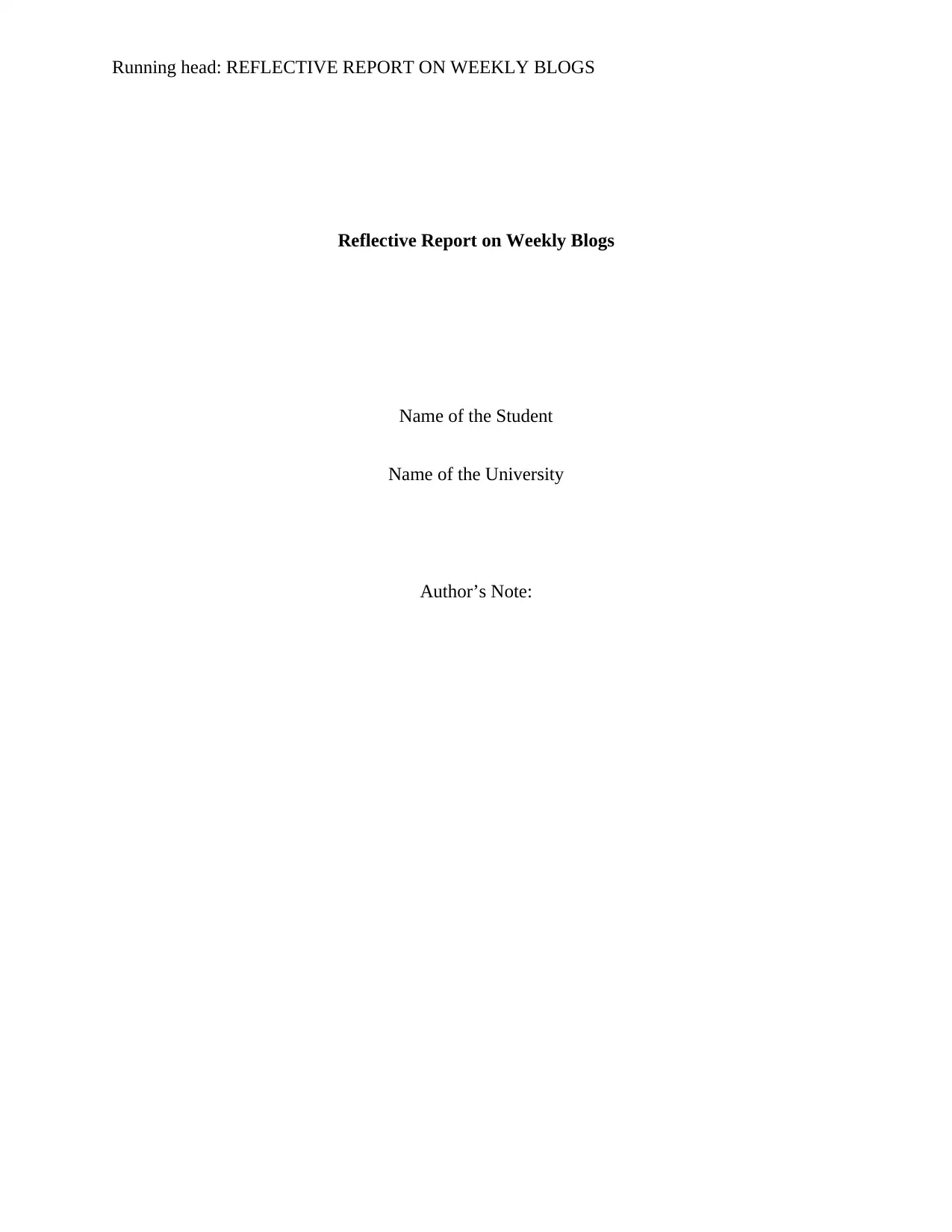
Running head: REFLECTIVE REPORT ON WEEKLY BLOGS
Reflective Report on Weekly Blogs
Name of the Student
Name of the University
Author’s Note:
Reflective Report on Weekly Blogs
Name of the Student
Name of the University
Author’s Note:
Secure Best Marks with AI Grader
Need help grading? Try our AI Grader for instant feedback on your assignments.
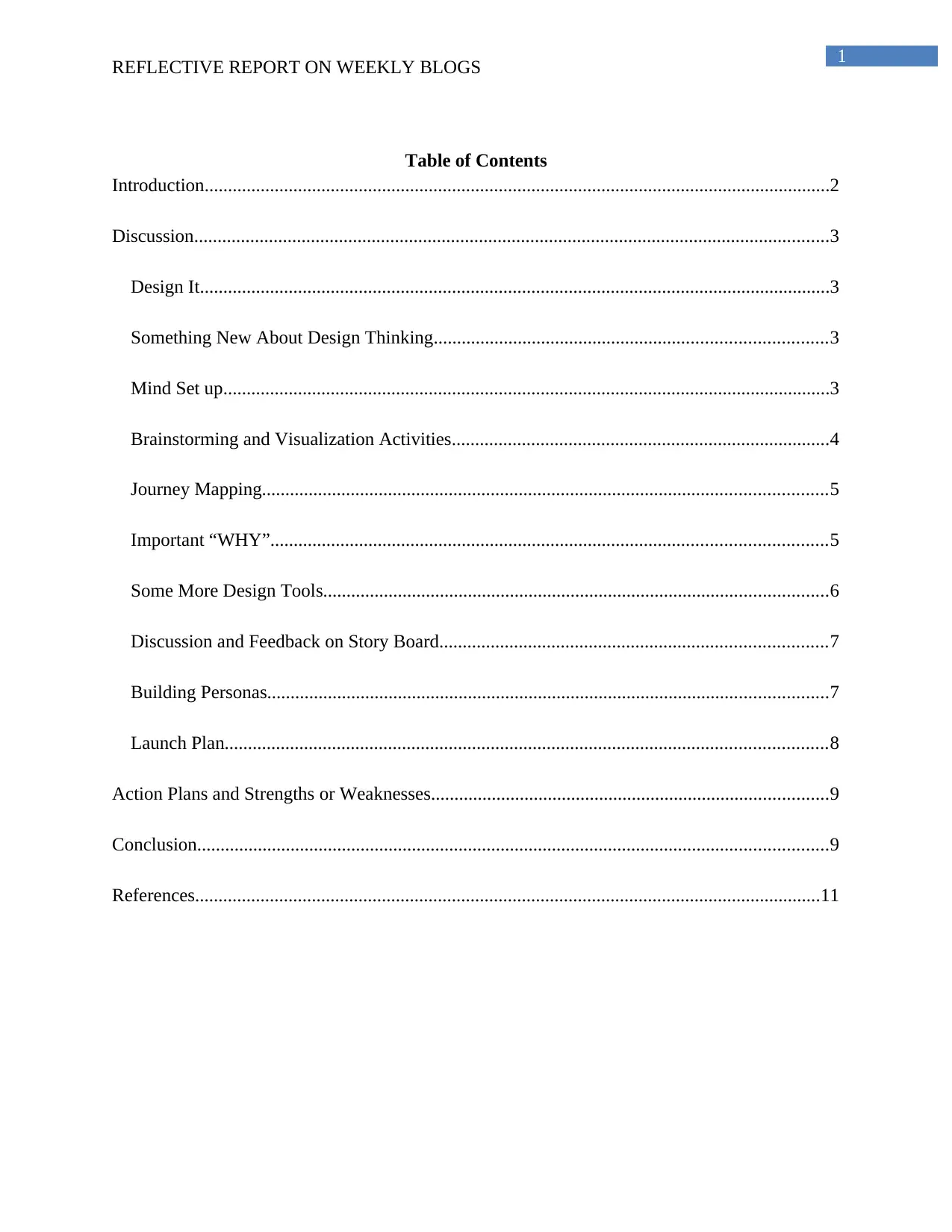
1
REFLECTIVE REPORT ON WEEKLY BLOGS
Table of Contents
Introduction......................................................................................................................................2
Discussion........................................................................................................................................3
Design It.......................................................................................................................................3
Something New About Design Thinking....................................................................................3
Mind Set up..................................................................................................................................3
Brainstorming and Visualization Activities.................................................................................4
Journey Mapping.........................................................................................................................5
Important “WHY”.......................................................................................................................5
Some More Design Tools............................................................................................................6
Discussion and Feedback on Story Board...................................................................................7
Building Personas........................................................................................................................7
Launch Plan.................................................................................................................................8
Action Plans and Strengths or Weaknesses.....................................................................................9
Conclusion.......................................................................................................................................9
References......................................................................................................................................11
REFLECTIVE REPORT ON WEEKLY BLOGS
Table of Contents
Introduction......................................................................................................................................2
Discussion........................................................................................................................................3
Design It.......................................................................................................................................3
Something New About Design Thinking....................................................................................3
Mind Set up..................................................................................................................................3
Brainstorming and Visualization Activities.................................................................................4
Journey Mapping.........................................................................................................................5
Important “WHY”.......................................................................................................................5
Some More Design Tools............................................................................................................6
Discussion and Feedback on Story Board...................................................................................7
Building Personas........................................................................................................................7
Launch Plan.................................................................................................................................8
Action Plans and Strengths or Weaknesses.....................................................................................9
Conclusion.......................................................................................................................................9
References......................................................................................................................................11

2
REFLECTIVE REPORT ON WEEKLY BLOGS
Introduction
Design thinking is the procedure that is utilized by all designers for solving complex and
complicated problems and thus finding reasonable solutions for their clients (Johansson‐
Sköldberg, Woodilla & Çetinkaya, 2013). This particular process draws upon the systematic
reasoning, imagination, intuition and logic for exploring the possibilities of probable outcomes
and creating the desired results, which would be beneficial for the end user. I have learnt that
design thinking is extremely important and useful for any complex problems. From my ten
weekly blogs starting from 17th July 2017 to 30th September 2017, I have shared my complete
knowledge regarding design thinking (Bjögvinsson, Ehn & Hillgren, 2012). I have discussed all
types of topics related to design thinking like design it, something new about design thinking,
mind set up, brainstorming and visualization activities, journey mapping, some of the design
tools, discussion and feedback on story board, building personas and launch plan. I have shared
my personal experiences regarding these topics.
In the following report I have outlined my ten weekly blogs that I have written from 17th
July 2017 to 30th September 2017. Each of the blogs is described with my personal experiences
and the knowledge I have gained from those activities (Razzouk & Shute, 2012). The blogs are
completely based on design thinking and the activities that I have done are on design thinking. I
have provided the description of my weekly blogs in the following paragraphs. Moreover, my
strengths and weaknesses are also mentioned here.
REFLECTIVE REPORT ON WEEKLY BLOGS
Introduction
Design thinking is the procedure that is utilized by all designers for solving complex and
complicated problems and thus finding reasonable solutions for their clients (Johansson‐
Sköldberg, Woodilla & Çetinkaya, 2013). This particular process draws upon the systematic
reasoning, imagination, intuition and logic for exploring the possibilities of probable outcomes
and creating the desired results, which would be beneficial for the end user. I have learnt that
design thinking is extremely important and useful for any complex problems. From my ten
weekly blogs starting from 17th July 2017 to 30th September 2017, I have shared my complete
knowledge regarding design thinking (Bjögvinsson, Ehn & Hillgren, 2012). I have discussed all
types of topics related to design thinking like design it, something new about design thinking,
mind set up, brainstorming and visualization activities, journey mapping, some of the design
tools, discussion and feedback on story board, building personas and launch plan. I have shared
my personal experiences regarding these topics.
In the following report I have outlined my ten weekly blogs that I have written from 17th
July 2017 to 30th September 2017. Each of the blogs is described with my personal experiences
and the knowledge I have gained from those activities (Razzouk & Shute, 2012). The blogs are
completely based on design thinking and the activities that I have done are on design thinking. I
have provided the description of my weekly blogs in the following paragraphs. Moreover, my
strengths and weaknesses are also mentioned here.
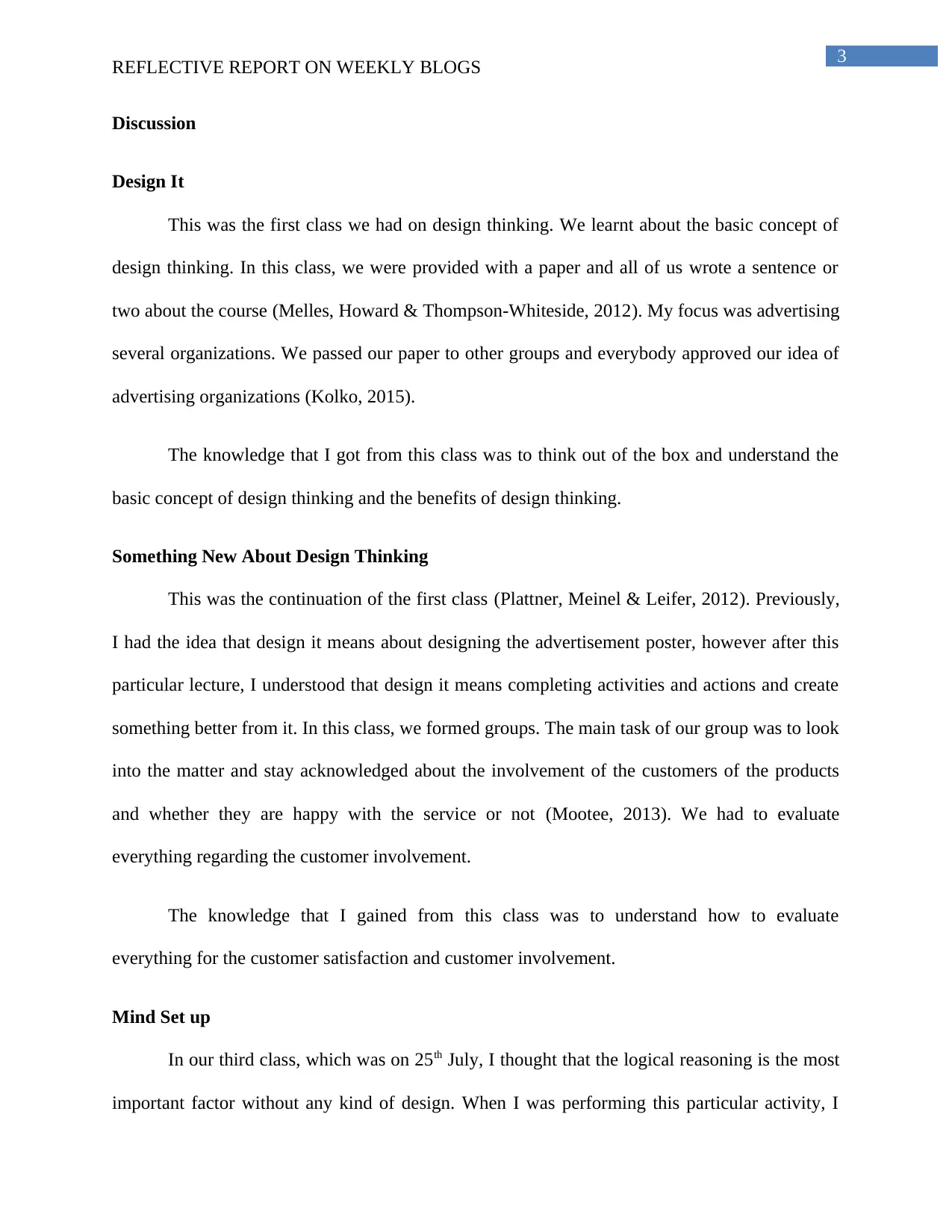
3
REFLECTIVE REPORT ON WEEKLY BLOGS
Discussion
Design It
This was the first class we had on design thinking. We learnt about the basic concept of
design thinking. In this class, we were provided with a paper and all of us wrote a sentence or
two about the course (Melles, Howard & Thompson-Whiteside, 2012). My focus was advertising
several organizations. We passed our paper to other groups and everybody approved our idea of
advertising organizations (Kolko, 2015).
The knowledge that I got from this class was to think out of the box and understand the
basic concept of design thinking and the benefits of design thinking.
Something New About Design Thinking
This was the continuation of the first class (Plattner, Meinel & Leifer, 2012). Previously,
I had the idea that design it means about designing the advertisement poster, however after this
particular lecture, I understood that design it means completing activities and actions and create
something better from it. In this class, we formed groups. The main task of our group was to look
into the matter and stay acknowledged about the involvement of the customers of the products
and whether they are happy with the service or not (Mootee, 2013). We had to evaluate
everything regarding the customer involvement.
The knowledge that I gained from this class was to understand how to evaluate
everything for the customer satisfaction and customer involvement.
Mind Set up
In our third class, which was on 25th July, I thought that the logical reasoning is the most
important factor without any kind of design. When I was performing this particular activity, I
REFLECTIVE REPORT ON WEEKLY BLOGS
Discussion
Design It
This was the first class we had on design thinking. We learnt about the basic concept of
design thinking. In this class, we were provided with a paper and all of us wrote a sentence or
two about the course (Melles, Howard & Thompson-Whiteside, 2012). My focus was advertising
several organizations. We passed our paper to other groups and everybody approved our idea of
advertising organizations (Kolko, 2015).
The knowledge that I got from this class was to think out of the box and understand the
basic concept of design thinking and the benefits of design thinking.
Something New About Design Thinking
This was the continuation of the first class (Plattner, Meinel & Leifer, 2012). Previously,
I had the idea that design it means about designing the advertisement poster, however after this
particular lecture, I understood that design it means completing activities and actions and create
something better from it. In this class, we formed groups. The main task of our group was to look
into the matter and stay acknowledged about the involvement of the customers of the products
and whether they are happy with the service or not (Mootee, 2013). We had to evaluate
everything regarding the customer involvement.
The knowledge that I gained from this class was to understand how to evaluate
everything for the customer satisfaction and customer involvement.
Mind Set up
In our third class, which was on 25th July, I thought that the logical reasoning is the most
important factor without any kind of design. When I was performing this particular activity, I
Secure Best Marks with AI Grader
Need help grading? Try our AI Grader for instant feedback on your assignments.
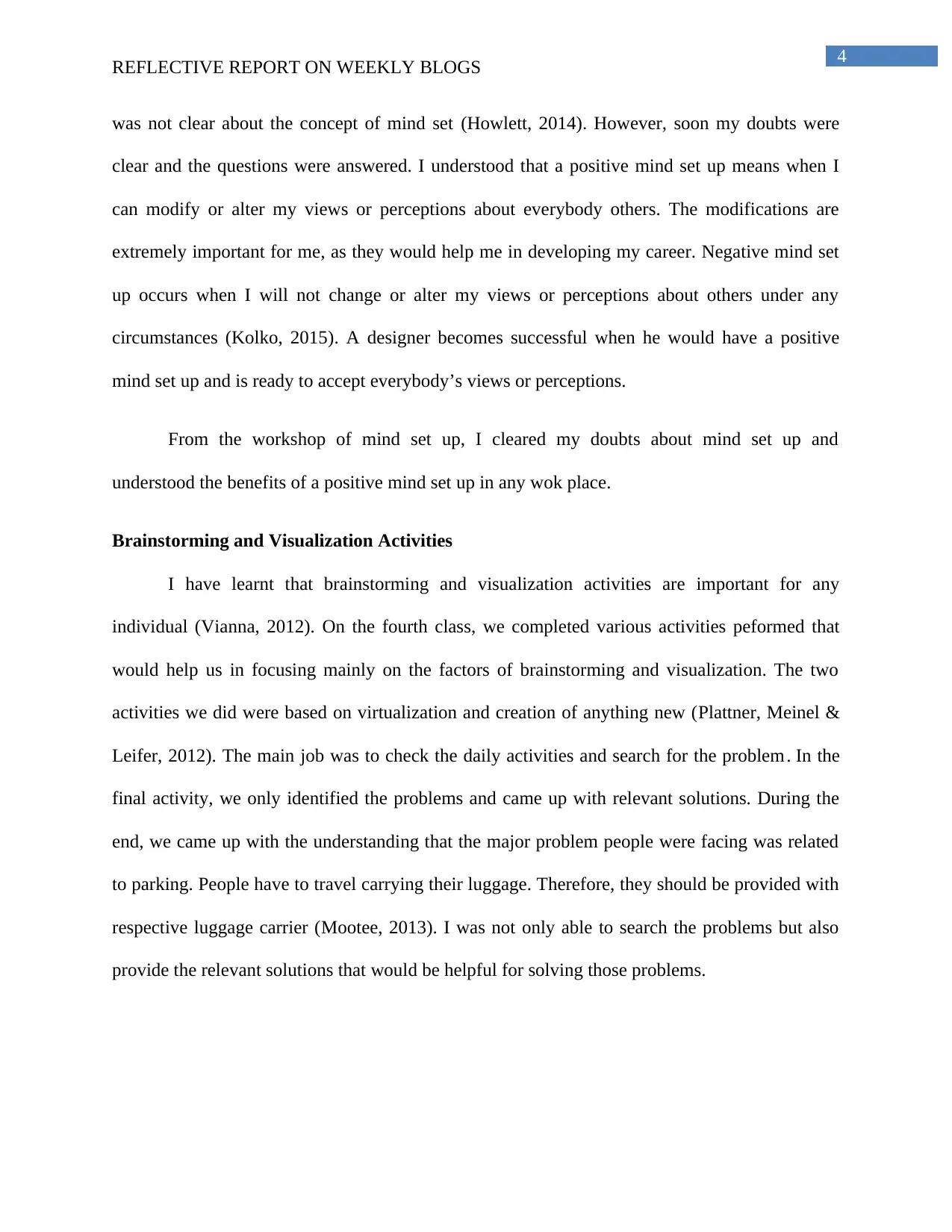
4
REFLECTIVE REPORT ON WEEKLY BLOGS
was not clear about the concept of mind set (Howlett, 2014). However, soon my doubts were
clear and the questions were answered. I understood that a positive mind set up means when I
can modify or alter my views or perceptions about everybody others. The modifications are
extremely important for me, as they would help me in developing my career. Negative mind set
up occurs when I will not change or alter my views or perceptions about others under any
circumstances (Kolko, 2015). A designer becomes successful when he would have a positive
mind set up and is ready to accept everybody’s views or perceptions.
From the workshop of mind set up, I cleared my doubts about mind set up and
understood the benefits of a positive mind set up in any wok place.
Brainstorming and Visualization Activities
I have learnt that brainstorming and visualization activities are important for any
individual (Vianna, 2012). On the fourth class, we completed various activities peformed that
would help us in focusing mainly on the factors of brainstorming and visualization. The two
activities we did were based on virtualization and creation of anything new (Plattner, Meinel &
Leifer, 2012). The main job was to check the daily activities and search for the problem. In the
final activity, we only identified the problems and came up with relevant solutions. During the
end, we came up with the understanding that the major problem people were facing was related
to parking. People have to travel carrying their luggage. Therefore, they should be provided with
respective luggage carrier (Mootee, 2013). I was not only able to search the problems but also
provide the relevant solutions that would be helpful for solving those problems.
REFLECTIVE REPORT ON WEEKLY BLOGS
was not clear about the concept of mind set (Howlett, 2014). However, soon my doubts were
clear and the questions were answered. I understood that a positive mind set up means when I
can modify or alter my views or perceptions about everybody others. The modifications are
extremely important for me, as they would help me in developing my career. Negative mind set
up occurs when I will not change or alter my views or perceptions about others under any
circumstances (Kolko, 2015). A designer becomes successful when he would have a positive
mind set up and is ready to accept everybody’s views or perceptions.
From the workshop of mind set up, I cleared my doubts about mind set up and
understood the benefits of a positive mind set up in any wok place.
Brainstorming and Visualization Activities
I have learnt that brainstorming and visualization activities are important for any
individual (Vianna, 2012). On the fourth class, we completed various activities peformed that
would help us in focusing mainly on the factors of brainstorming and visualization. The two
activities we did were based on virtualization and creation of anything new (Plattner, Meinel &
Leifer, 2012). The main job was to check the daily activities and search for the problem. In the
final activity, we only identified the problems and came up with relevant solutions. During the
end, we came up with the understanding that the major problem people were facing was related
to parking. People have to travel carrying their luggage. Therefore, they should be provided with
respective luggage carrier (Mootee, 2013). I was not only able to search the problems but also
provide the relevant solutions that would be helpful for solving those problems.
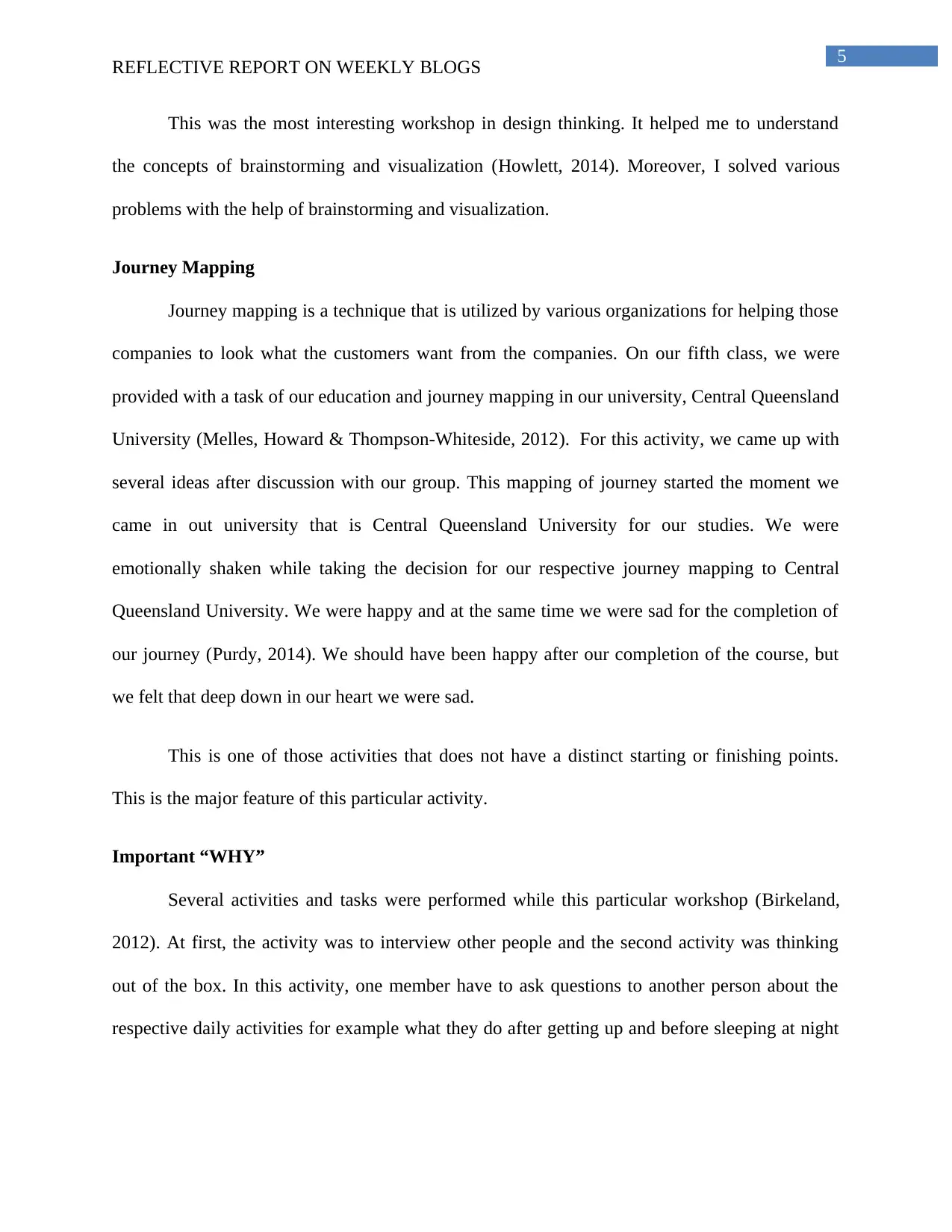
5
REFLECTIVE REPORT ON WEEKLY BLOGS
This was the most interesting workshop in design thinking. It helped me to understand
the concepts of brainstorming and visualization (Howlett, 2014). Moreover, I solved various
problems with the help of brainstorming and visualization.
Journey Mapping
Journey mapping is a technique that is utilized by various organizations for helping those
companies to look what the customers want from the companies. On our fifth class, we were
provided with a task of our education and journey mapping in our university, Central Queensland
University (Melles, Howard & Thompson-Whiteside, 2012). For this activity, we came up with
several ideas after discussion with our group. This mapping of journey started the moment we
came in out university that is Central Queensland University for our studies. We were
emotionally shaken while taking the decision for our respective journey mapping to Central
Queensland University. We were happy and at the same time we were sad for the completion of
our journey (Purdy, 2014). We should have been happy after our completion of the course, but
we felt that deep down in our heart we were sad.
This is one of those activities that does not have a distinct starting or finishing points.
This is the major feature of this particular activity.
Important “WHY”
Several activities and tasks were performed while this particular workshop (Birkeland,
2012). At first, the activity was to interview other people and the second activity was thinking
out of the box. In this activity, one member have to ask questions to another person about the
respective daily activities for example what they do after getting up and before sleeping at night
REFLECTIVE REPORT ON WEEKLY BLOGS
This was the most interesting workshop in design thinking. It helped me to understand
the concepts of brainstorming and visualization (Howlett, 2014). Moreover, I solved various
problems with the help of brainstorming and visualization.
Journey Mapping
Journey mapping is a technique that is utilized by various organizations for helping those
companies to look what the customers want from the companies. On our fifth class, we were
provided with a task of our education and journey mapping in our university, Central Queensland
University (Melles, Howard & Thompson-Whiteside, 2012). For this activity, we came up with
several ideas after discussion with our group. This mapping of journey started the moment we
came in out university that is Central Queensland University for our studies. We were
emotionally shaken while taking the decision for our respective journey mapping to Central
Queensland University. We were happy and at the same time we were sad for the completion of
our journey (Purdy, 2014). We should have been happy after our completion of the course, but
we felt that deep down in our heart we were sad.
This is one of those activities that does not have a distinct starting or finishing points.
This is the major feature of this particular activity.
Important “WHY”
Several activities and tasks were performed while this particular workshop (Birkeland,
2012). At first, the activity was to interview other people and the second activity was thinking
out of the box. In this activity, one member have to ask questions to another person about the
respective daily activities for example what they do after getting up and before sleeping at night
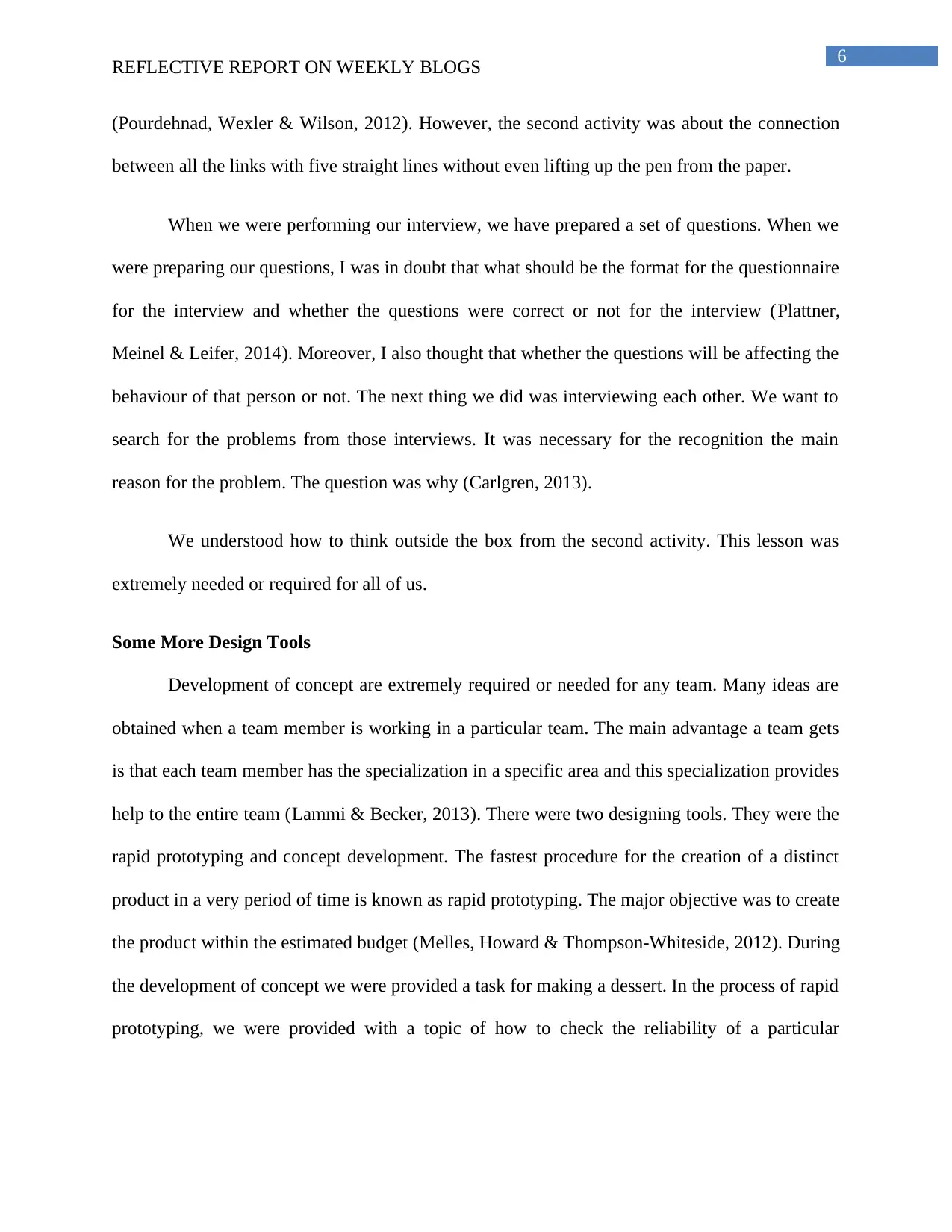
6
REFLECTIVE REPORT ON WEEKLY BLOGS
(Pourdehnad, Wexler & Wilson, 2012). However, the second activity was about the connection
between all the links with five straight lines without even lifting up the pen from the paper.
When we were performing our interview, we have prepared a set of questions. When we
were preparing our questions, I was in doubt that what should be the format for the questionnaire
for the interview and whether the questions were correct or not for the interview (Plattner,
Meinel & Leifer, 2014). Moreover, I also thought that whether the questions will be affecting the
behaviour of that person or not. The next thing we did was interviewing each other. We want to
search for the problems from those interviews. It was necessary for the recognition the main
reason for the problem. The question was why (Carlgren, 2013).
We understood how to think outside the box from the second activity. This lesson was
extremely needed or required for all of us.
Some More Design Tools
Development of concept are extremely required or needed for any team. Many ideas are
obtained when a team member is working in a particular team. The main advantage a team gets
is that each team member has the specialization in a specific area and this specialization provides
help to the entire team (Lammi & Becker, 2013). There were two designing tools. They were the
rapid prototyping and concept development. The fastest procedure for the creation of a distinct
product in a very period of time is known as rapid prototyping. The major objective was to create
the product within the estimated budget (Melles, Howard & Thompson-Whiteside, 2012). During
the development of concept we were provided a task for making a dessert. In the process of rapid
prototyping, we were provided with a topic of how to check the reliability of a particular
REFLECTIVE REPORT ON WEEKLY BLOGS
(Pourdehnad, Wexler & Wilson, 2012). However, the second activity was about the connection
between all the links with five straight lines without even lifting up the pen from the paper.
When we were performing our interview, we have prepared a set of questions. When we
were preparing our questions, I was in doubt that what should be the format for the questionnaire
for the interview and whether the questions were correct or not for the interview (Plattner,
Meinel & Leifer, 2014). Moreover, I also thought that whether the questions will be affecting the
behaviour of that person or not. The next thing we did was interviewing each other. We want to
search for the problems from those interviews. It was necessary for the recognition the main
reason for the problem. The question was why (Carlgren, 2013).
We understood how to think outside the box from the second activity. This lesson was
extremely needed or required for all of us.
Some More Design Tools
Development of concept are extremely required or needed for any team. Many ideas are
obtained when a team member is working in a particular team. The main advantage a team gets
is that each team member has the specialization in a specific area and this specialization provides
help to the entire team (Lammi & Becker, 2013). There were two designing tools. They were the
rapid prototyping and concept development. The fastest procedure for the creation of a distinct
product in a very period of time is known as rapid prototyping. The major objective was to create
the product within the estimated budget (Melles, Howard & Thompson-Whiteside, 2012). During
the development of concept we were provided a task for making a dessert. In the process of rapid
prototyping, we were provided with a topic of how to check the reliability of a particular
Paraphrase This Document
Need a fresh take? Get an instant paraphrase of this document with our AI Paraphraser

7
REFLECTIVE REPORT ON WEEKLY BLOGS
employee (Howlett, 2014). It was very difficult for the creation of such a prototype but somehow
we made a questionnaire.
The lesson we got from this workshop was to utilize the design thinking tools perfectly
and with efficiency.
Discussion and Feedback on Story Board
The prototype we have discussed was about an application of anti spoiler and was
extremely interesting. Another group (Plattner, Meinel & Leifer, 2014) made this prototype. It
clearly represented the problems, the people, who were facing the problems. The groups were
absolutely clear about their target audiences. The feedback was needed for this application
(Johansson‐Sköldberg, Woodilla & Çetinkaya, 2013). Finally, the discussion were done about
the prototype and were able to acquire feedback about what can be done for improving it. This
prototype not only helps in reduction of cost and saving the time. Positive feedbacks were
absolutely needed for this activity.
The lesson we got from this particular activity was creating a prototype and finally
delivering it to the customers (Bjögvinsson, Ehn & Hillgren, 2012). We also learn to identify our
customers and the using of designing tools.
Building Personas
Personas are the imaginary characters that are considered determining who will be using
the products. In our ninth class, we learnt about personas (Lammi & Becker, 2013). This class
helped me in identifying our target audiences, market and their behaviours and requirements.
When we were discussing about activity, we thought of creation of the personas. The focus was
on the requirements of the customers (Vianna, 2012). Personas even help in making positions of
REFLECTIVE REPORT ON WEEKLY BLOGS
employee (Howlett, 2014). It was very difficult for the creation of such a prototype but somehow
we made a questionnaire.
The lesson we got from this workshop was to utilize the design thinking tools perfectly
and with efficiency.
Discussion and Feedback on Story Board
The prototype we have discussed was about an application of anti spoiler and was
extremely interesting. Another group (Plattner, Meinel & Leifer, 2014) made this prototype. It
clearly represented the problems, the people, who were facing the problems. The groups were
absolutely clear about their target audiences. The feedback was needed for this application
(Johansson‐Sköldberg, Woodilla & Çetinkaya, 2013). Finally, the discussion were done about
the prototype and were able to acquire feedback about what can be done for improving it. This
prototype not only helps in reduction of cost and saving the time. Positive feedbacks were
absolutely needed for this activity.
The lesson we got from this particular activity was creating a prototype and finally
delivering it to the customers (Bjögvinsson, Ehn & Hillgren, 2012). We also learn to identify our
customers and the using of designing tools.
Building Personas
Personas are the imaginary characters that are considered determining who will be using
the products. In our ninth class, we learnt about personas (Lammi & Becker, 2013). This class
helped me in identifying our target audiences, market and their behaviours and requirements.
When we were discussing about activity, we thought of creation of the personas. The focus was
on the requirements of the customers (Vianna, 2012). Personas even help in making positions of
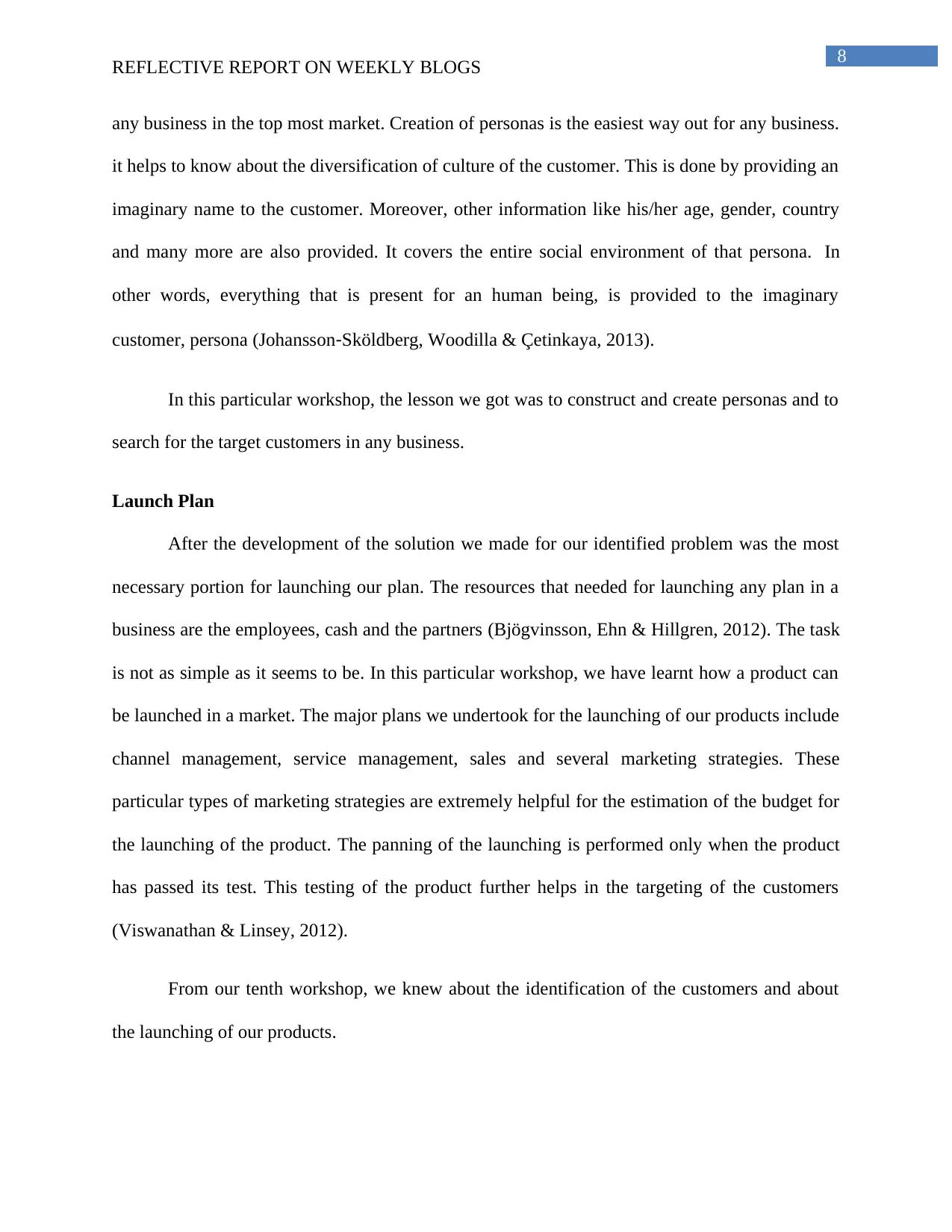
8
REFLECTIVE REPORT ON WEEKLY BLOGS
any business in the top most market. Creation of personas is the easiest way out for any business.
it helps to know about the diversification of culture of the customer. This is done by providing an
imaginary name to the customer. Moreover, other information like his/her age, gender, country
and many more are also provided. It covers the entire social environment of that persona. In
other words, everything that is present for an human being, is provided to the imaginary
customer, persona (Johansson‐Sköldberg, Woodilla & Çetinkaya, 2013).
In this particular workshop, the lesson we got was to construct and create personas and to
search for the target customers in any business.
Launch Plan
After the development of the solution we made for our identified problem was the most
necessary portion for launching our plan. The resources that needed for launching any plan in a
business are the employees, cash and the partners (Bjögvinsson, Ehn & Hillgren, 2012). The task
is not as simple as it seems to be. In this particular workshop, we have learnt how a product can
be launched in a market. The major plans we undertook for the launching of our products include
channel management, service management, sales and several marketing strategies. These
particular types of marketing strategies are extremely helpful for the estimation of the budget for
the launching of the product. The panning of the launching is performed only when the product
has passed its test. This testing of the product further helps in the targeting of the customers
(Viswanathan & Linsey, 2012).
From our tenth workshop, we knew about the identification of the customers and about
the launching of our products.
REFLECTIVE REPORT ON WEEKLY BLOGS
any business in the top most market. Creation of personas is the easiest way out for any business.
it helps to know about the diversification of culture of the customer. This is done by providing an
imaginary name to the customer. Moreover, other information like his/her age, gender, country
and many more are also provided. It covers the entire social environment of that persona. In
other words, everything that is present for an human being, is provided to the imaginary
customer, persona (Johansson‐Sköldberg, Woodilla & Çetinkaya, 2013).
In this particular workshop, the lesson we got was to construct and create personas and to
search for the target customers in any business.
Launch Plan
After the development of the solution we made for our identified problem was the most
necessary portion for launching our plan. The resources that needed for launching any plan in a
business are the employees, cash and the partners (Bjögvinsson, Ehn & Hillgren, 2012). The task
is not as simple as it seems to be. In this particular workshop, we have learnt how a product can
be launched in a market. The major plans we undertook for the launching of our products include
channel management, service management, sales and several marketing strategies. These
particular types of marketing strategies are extremely helpful for the estimation of the budget for
the launching of the product. The panning of the launching is performed only when the product
has passed its test. This testing of the product further helps in the targeting of the customers
(Viswanathan & Linsey, 2012).
From our tenth workshop, we knew about the identification of the customers and about
the launching of our products.
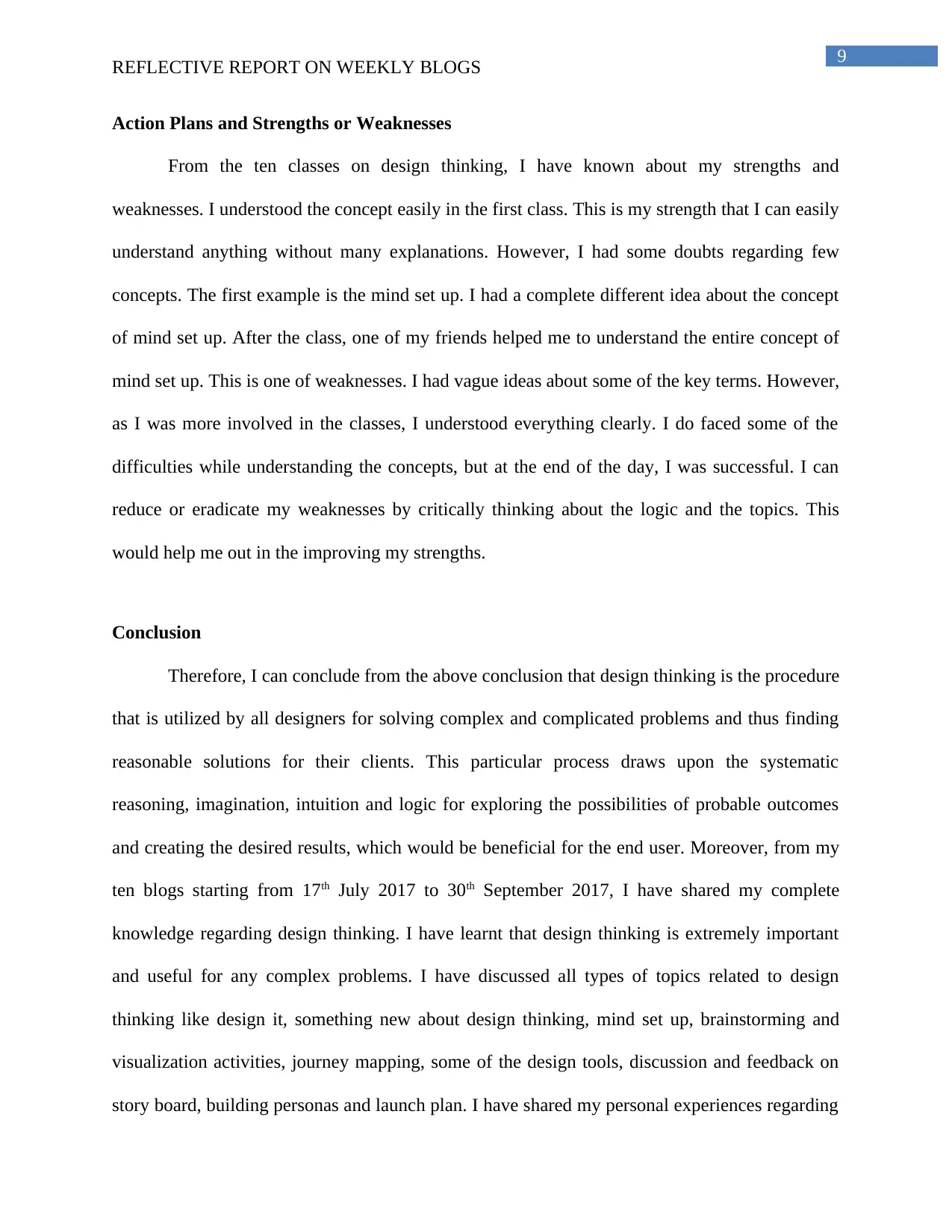
9
REFLECTIVE REPORT ON WEEKLY BLOGS
Action Plans and Strengths or Weaknesses
From the ten classes on design thinking, I have known about my strengths and
weaknesses. I understood the concept easily in the first class. This is my strength that I can easily
understand anything without many explanations. However, I had some doubts regarding few
concepts. The first example is the mind set up. I had a complete different idea about the concept
of mind set up. After the class, one of my friends helped me to understand the entire concept of
mind set up. This is one of weaknesses. I had vague ideas about some of the key terms. However,
as I was more involved in the classes, I understood everything clearly. I do faced some of the
difficulties while understanding the concepts, but at the end of the day, I was successful. I can
reduce or eradicate my weaknesses by critically thinking about the logic and the topics. This
would help me out in the improving my strengths.
Conclusion
Therefore, I can conclude from the above conclusion that design thinking is the procedure
that is utilized by all designers for solving complex and complicated problems and thus finding
reasonable solutions for their clients. This particular process draws upon the systematic
reasoning, imagination, intuition and logic for exploring the possibilities of probable outcomes
and creating the desired results, which would be beneficial for the end user. Moreover, from my
ten blogs starting from 17th July 2017 to 30th September 2017, I have shared my complete
knowledge regarding design thinking. I have learnt that design thinking is extremely important
and useful for any complex problems. I have discussed all types of topics related to design
thinking like design it, something new about design thinking, mind set up, brainstorming and
visualization activities, journey mapping, some of the design tools, discussion and feedback on
story board, building personas and launch plan. I have shared my personal experiences regarding
REFLECTIVE REPORT ON WEEKLY BLOGS
Action Plans and Strengths or Weaknesses
From the ten classes on design thinking, I have known about my strengths and
weaknesses. I understood the concept easily in the first class. This is my strength that I can easily
understand anything without many explanations. However, I had some doubts regarding few
concepts. The first example is the mind set up. I had a complete different idea about the concept
of mind set up. After the class, one of my friends helped me to understand the entire concept of
mind set up. This is one of weaknesses. I had vague ideas about some of the key terms. However,
as I was more involved in the classes, I understood everything clearly. I do faced some of the
difficulties while understanding the concepts, but at the end of the day, I was successful. I can
reduce or eradicate my weaknesses by critically thinking about the logic and the topics. This
would help me out in the improving my strengths.
Conclusion
Therefore, I can conclude from the above conclusion that design thinking is the procedure
that is utilized by all designers for solving complex and complicated problems and thus finding
reasonable solutions for their clients. This particular process draws upon the systematic
reasoning, imagination, intuition and logic for exploring the possibilities of probable outcomes
and creating the desired results, which would be beneficial for the end user. Moreover, from my
ten blogs starting from 17th July 2017 to 30th September 2017, I have shared my complete
knowledge regarding design thinking. I have learnt that design thinking is extremely important
and useful for any complex problems. I have discussed all types of topics related to design
thinking like design it, something new about design thinking, mind set up, brainstorming and
visualization activities, journey mapping, some of the design tools, discussion and feedback on
story board, building personas and launch plan. I have shared my personal experiences regarding
Secure Best Marks with AI Grader
Need help grading? Try our AI Grader for instant feedback on your assignments.

10
REFLECTIVE REPORT ON WEEKLY BLOGS
these topics. I have discussed in the above report about the details of my ten weekly blogs. I have
also described how design thinking is related to personal experiences. The above report also
contains my action plans, that my strengths and weaknesses from the ten workshops.
REFLECTIVE REPORT ON WEEKLY BLOGS
these topics. I have discussed in the above report about the details of my ten weekly blogs. I have
also described how design thinking is related to personal experiences. The above report also
contains my action plans, that my strengths and weaknesses from the ten workshops.
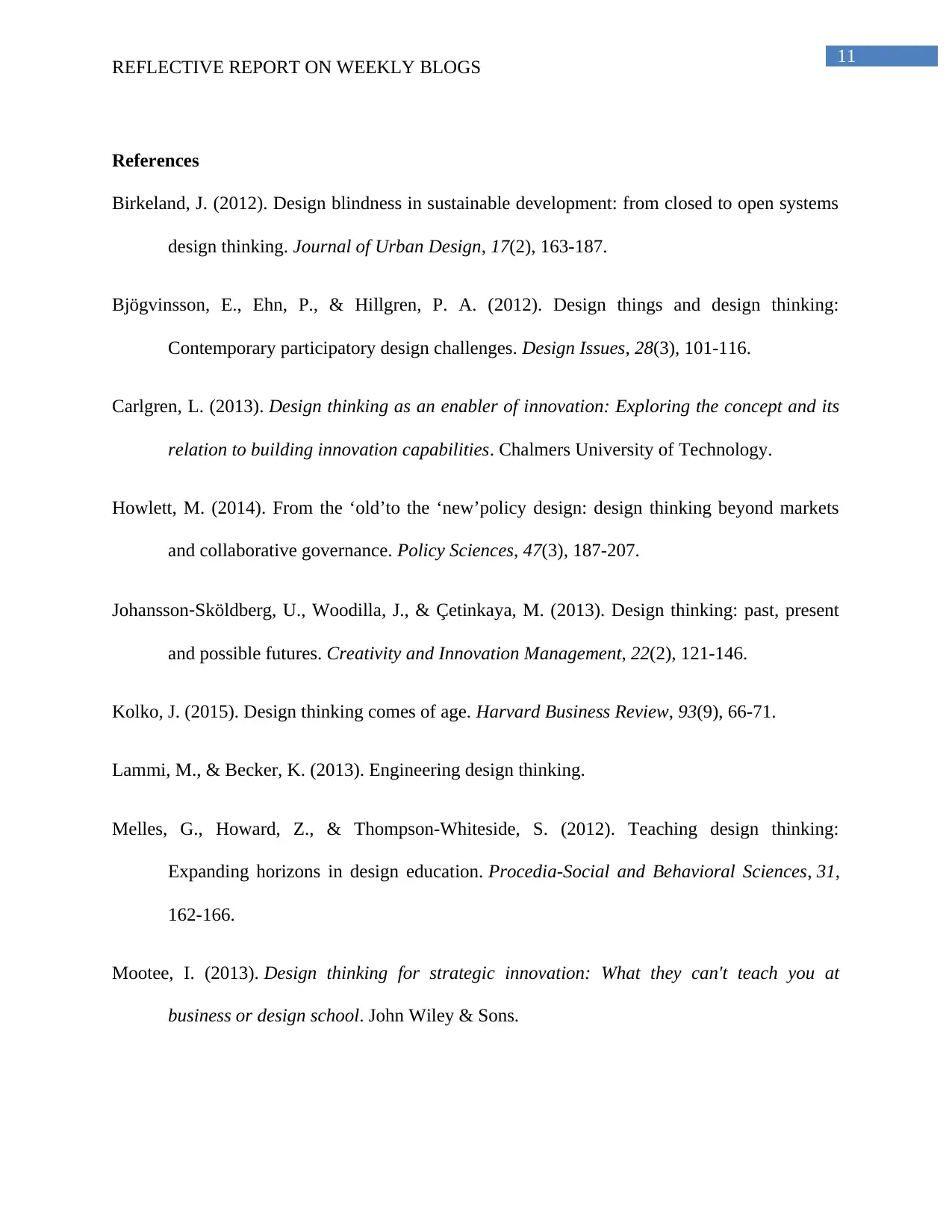
11
REFLECTIVE REPORT ON WEEKLY BLOGS
References
Birkeland, J. (2012). Design blindness in sustainable development: from closed to open systems
design thinking. Journal of Urban Design, 17(2), 163-187.
Bjögvinsson, E., Ehn, P., & Hillgren, P. A. (2012). Design things and design thinking:
Contemporary participatory design challenges. Design Issues, 28(3), 101-116.
Carlgren, L. (2013). Design thinking as an enabler of innovation: Exploring the concept and its
relation to building innovation capabilities. Chalmers University of Technology.
Howlett, M. (2014). From the ‘old’to the ‘new’policy design: design thinking beyond markets
and collaborative governance. Policy Sciences, 47(3), 187-207.
Johansson‐Sköldberg, U., Woodilla, J., & Çetinkaya, M. (2013). Design thinking: past, present
and possible futures. Creativity and Innovation Management, 22(2), 121-146.
Kolko, J. (2015). Design thinking comes of age. Harvard Business Review, 93(9), 66-71.
Lammi, M., & Becker, K. (2013). Engineering design thinking.
Melles, G., Howard, Z., & Thompson-Whiteside, S. (2012). Teaching design thinking:
Expanding horizons in design education. Procedia-Social and Behavioral Sciences, 31,
162-166.
Mootee, I. (2013). Design thinking for strategic innovation: What they can't teach you at
business or design school. John Wiley & Sons.
REFLECTIVE REPORT ON WEEKLY BLOGS
References
Birkeland, J. (2012). Design blindness in sustainable development: from closed to open systems
design thinking. Journal of Urban Design, 17(2), 163-187.
Bjögvinsson, E., Ehn, P., & Hillgren, P. A. (2012). Design things and design thinking:
Contemporary participatory design challenges. Design Issues, 28(3), 101-116.
Carlgren, L. (2013). Design thinking as an enabler of innovation: Exploring the concept and its
relation to building innovation capabilities. Chalmers University of Technology.
Howlett, M. (2014). From the ‘old’to the ‘new’policy design: design thinking beyond markets
and collaborative governance. Policy Sciences, 47(3), 187-207.
Johansson‐Sköldberg, U., Woodilla, J., & Çetinkaya, M. (2013). Design thinking: past, present
and possible futures. Creativity and Innovation Management, 22(2), 121-146.
Kolko, J. (2015). Design thinking comes of age. Harvard Business Review, 93(9), 66-71.
Lammi, M., & Becker, K. (2013). Engineering design thinking.
Melles, G., Howard, Z., & Thompson-Whiteside, S. (2012). Teaching design thinking:
Expanding horizons in design education. Procedia-Social and Behavioral Sciences, 31,
162-166.
Mootee, I. (2013). Design thinking for strategic innovation: What they can't teach you at
business or design school. John Wiley & Sons.

12
REFLECTIVE REPORT ON WEEKLY BLOGS
Noweski, C., Scheer, A., Büttner, N., von Thienen, J., Erdmann, J., & Meinel, C. (2012).
Towards a paradigm shift in education practice: Developing twenty-first century skills
with design thinking. In Design thinking research (pp. 71-94). Springer Berlin
Heidelberg.
Plattner, H., Meinel, C., & Leifer, L. (2012). Design thinking research. Springer.
Plattner, H., Meinel, C., & Leifer, L. (Eds.). (2014). Design Thinking Research: Building
Innovators. Springer.
Pourdehnad, J., Wexler, E. R., & Wilson, D. V. (2012). Systems & design thinking: A
conceptual framework for their integration. Проблемы управления в социальных
системах, 4(6).
Purdy, J. P. (2014). What can design thinking offer writing studies?. College composition and
communication, 65(4), 612.
Razzouk, R., & Shute, V. (2012). What is design thinking and why is it important?. Review of
Educational Research, 82(3), 330-348.
Vianna, M. (2012). Design Thinking: inovação em negócios. Design Thinking.
Viswanathan, V. K., & Linsey, J. S. (2012). Physical models and design thinking: A study of
functionality, novelty and variety of ideas. Journal of Mechanical Design, 134(9),
091004.
REFLECTIVE REPORT ON WEEKLY BLOGS
Noweski, C., Scheer, A., Büttner, N., von Thienen, J., Erdmann, J., & Meinel, C. (2012).
Towards a paradigm shift in education practice: Developing twenty-first century skills
with design thinking. In Design thinking research (pp. 71-94). Springer Berlin
Heidelberg.
Plattner, H., Meinel, C., & Leifer, L. (2012). Design thinking research. Springer.
Plattner, H., Meinel, C., & Leifer, L. (Eds.). (2014). Design Thinking Research: Building
Innovators. Springer.
Pourdehnad, J., Wexler, E. R., & Wilson, D. V. (2012). Systems & design thinking: A
conceptual framework for their integration. Проблемы управления в социальных
системах, 4(6).
Purdy, J. P. (2014). What can design thinking offer writing studies?. College composition and
communication, 65(4), 612.
Razzouk, R., & Shute, V. (2012). What is design thinking and why is it important?. Review of
Educational Research, 82(3), 330-348.
Vianna, M. (2012). Design Thinking: inovação em negócios. Design Thinking.
Viswanathan, V. K., & Linsey, J. S. (2012). Physical models and design thinking: A study of
functionality, novelty and variety of ideas. Journal of Mechanical Design, 134(9),
091004.
1 out of 13
Related Documents
Your All-in-One AI-Powered Toolkit for Academic Success.
+13062052269
info@desklib.com
Available 24*7 on WhatsApp / Email
![[object Object]](/_next/static/media/star-bottom.7253800d.svg)
Unlock your academic potential
© 2024 | Zucol Services PVT LTD | All rights reserved.





